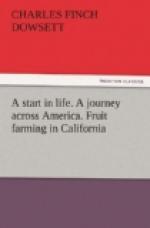We are now passing through cultivated lands, farms, and estates, and these continue right on to New York. At Greers was a very large collection of cotton. At Spartanville are large cotton mills, such as one sees in Lancashire. The next day (December 24th), we notice ice on the ponds. We cross the Potomac River, and near Washington, sight the Capitol—or, as we should say in England, the Houses of Parliament. Washington City is the political capital of the United States. Its size is about 4-1/2 miles by 2-1/2 miles. The Capitol is described by the Americans as the most magnificent public edifice in the world. It is 352 feet long and 121 feet deep, with two wings each 238 by 140 feet. Its entire length is 751 feet 4 inches, and it covers an area of more than 3-1/2 acres. It is of costly construction, and stands in grounds of about 50 acres.
We proceed, and stop at Baltimore, cross the Bush and Gunpowder Rivers, again come near the Susquehanna and Delaware Rivers, various smaller rivers, and run on until we reach New York. On arrival, I immediately went to the Cunard office and secured my berth in the “Servia.” The next morning (Christmas Day), it was very cold, and snowing. I had a fire lit in my bed-room, and there wrote the article which appeared in the January Land Roll. In the afternoon I walked in the Central Park, but it was so bitterly cold, I was satisfied with less than two hours of exercise, and returned to the hotel to dinner, and finished up the day writing in my bed-room till midnight. The Central Park, in genial weather, would be an attractive resort. I observed large natural rocks, lawns, wide promenades, seats, lakes, menageries, swings, and various such like attractions for juveniles, overground and underground roads—a kind of “Rotten Row,” &c., but being so cold scarcely a person was to be seen.
On December 26th, New York was deep in snow. I visited a few shops for some necessaries, and went on board the “Servia” during the afternoon, thinking that I might have difficulty in getting a cabman to drive to the docks after dark if the snow drifted deeply. New York City is the metropolis of the United States. In 1880 its population was 1,206,590. Its site was discovered in 1524. It was in 1609 that Hudson, an Englishman, ascended the river which was named after him. In 1614 some Dutchmen settled there. In 1648 its population was 1,000, and in 1700 it had increased to 6,000. In 1684 it was captured by the Duke of York, and was henceforth called “New York.” In 1711 a slave market was established in Wall Street.




